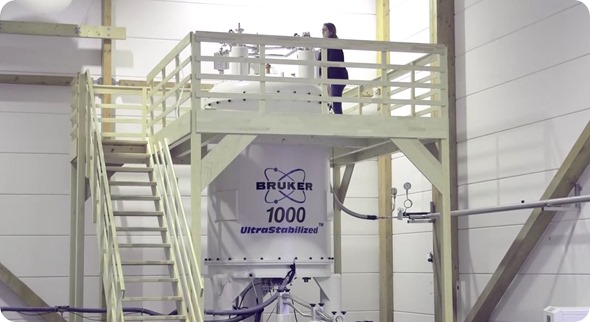Solid-state NMR spectroscopy is a technique used by scientists to provide valuable information in the analysis of solid materials. It provides unique and specific insights into the structure, dynamics, and reactivity of all kinds of materials.
At the Institute of Analytical Sciences in Lyon, France, a group of scientists are working on ways to make solid-state NMR a routine tool that researchers can use to characterize a wide range of important systems in biology and chemistry research. Solid-state NMR can be applied to a large range of chemically and biologically relevant targets that cannot be studied using other techniques.
Ultra-High Field Solid State NMR for Complex Biological Molecules
Ultra-High Field Solid State NMR for Complex Biological Molecules from AZoNetwork on Vimeo.
In an interview with News Medical, group leader Dr. Guido Pintacuda, highlighted some of the methods the team are developing to bring new and increasingly complex biomolecular targets within the reach of solid-state NMR.
In the majority of pharmaceutical development and research, structural insight into samples is provided by X-ray crystallography. Since samples that cannot be crystallized cannot benefit from this insight, Pintacuda and team are developing solid-state NMR that can be applied instead, in order to try and bring new classes of molecules into pharmaceutical development.
Examples of targets the team are interested in include protein assemblies, nucleic acid complexes and, more recently, membrane proteins. Membrane proteins, which are the cell gatekeepers and essential to cell function, are extremely difficult to characterize by any other technique; they are difficult to crystallize and often very difficult to solubilize without distortions.

“Therefore, the development of a proper solid-state NMR technique is crucial to studying these samples correctly at the atomic level, in the native environment,” said Pintacuda.
Pintacuda is particularly interested in samples containing paramagnetic metal ions, which are crucial to catalyzing important reactions in the biological and chemical world. The electronic structure of a metal ion is intimately connected to activity and reactivity, he explained, and by using NMR, key biophysical parameters can be directly accessed that are not accessible even when a molecule can be crystallized.
In the laboratory, the group have used solid-state NMR at the highest magnetic field currently available, which Pintacuda explained is vital because sensitivity and resolution are tightly related to magnetic field size. Working at this high magnetic field, the team have been able to really push the limit of their approach, tackling more complex and larger substrates than it is possible to at a lower field.

Pintacuda believes the availability of higher magnetic fields will make solid-state NMR a routine characterization technique for wider classes of molecules, of large molecular weight or available in very limited quantities.
What may look like an incremental change in magnetic field has a tremendous impact in terms of the complexity of the samples that can be analyzed and would bring large classes of molecules such as larger membrane proteins, which are now inaccessible to any other technique, within the scope of solid-state NMR.”
Dr Guido Pintacuda, Institute of Analytical Sciences, Lyon, France.
Working together with others in the field, the researchers have pioneered an approach based on very fast magic-angle spinning and very small rotors that enables the rapid rotation of a sample, for unprecedented benefits in resolution and sensitivity. This will also be helpful in expanding the size of the membrane proteins that can be analyzed by solid-state NMR.
Membrane proteins account for around 20 to 30% of all existing proteins and 50% of current drug targets. Yet, they make up less than 1% of the proteins characterized in the Protein Data Bank, a collection of the protein structures so far known about today. Therefore, the potential for structural and dynamical characterization of these important targets by solid-state NMR, is immense.

“The proof of concept for these molecules shows that solid-state NMR, an increase in magnetic field and possibly in magic-angle spinning speeds with faster probes, will make a large majority of these samples accessible in a fully protonated form” said Pintacuda.
This in itself would already be revolutionary, but there are further classes of molecules that lie outside even the scope of these latest developments and these too may well eventually become accessible when the next generation of magnets becomes available: “They will then drive the next generation of magnets, of even higher magnetic fields.”
Commenting on the history of NMR, Pintacuda points out how, since the beginning, there has always been collaboration with other techniques, with NMR providing specific and complementary information.
He thinks this should continue to be the case in the future: “We often see that our technique can also bridge different areas of science, and that the very same technique, approach, equipment and expertise are not specific to biomolecular research but can be applied to other problems in materials science and chemistry.”